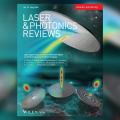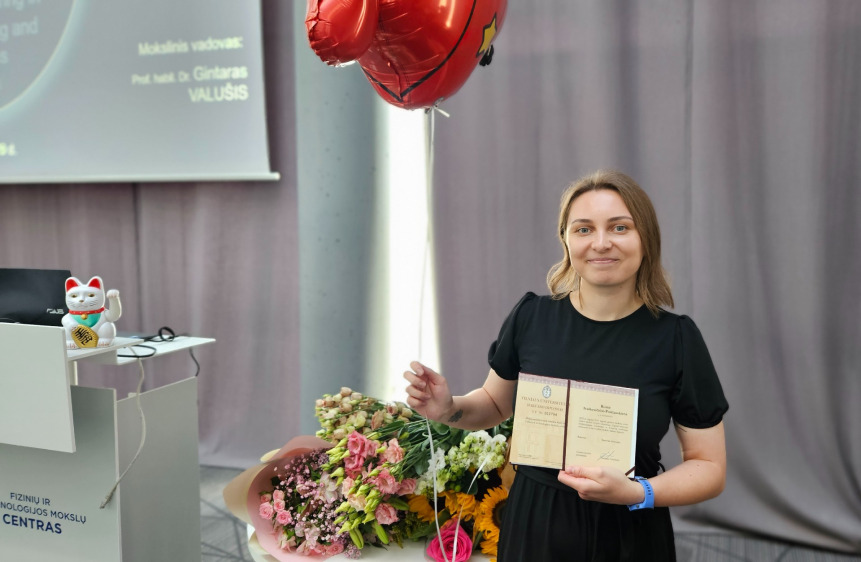Paieška
2023. 09. 29
-
R. Ivaškevičiūtė-Povilauskienė, who has presented world-class innovations in the field of terahertz, is the new PhD
Rusnė Ivaškevičiūtė-Povilauskienė, a researcher at the Department of Optoelectronics at FTMC, defended her PhD thesis on "Optical engineering in terahertz imaging and 2D materials inspection" (academic supervisor: Prof. Dr. habil. Gintaras Valušis).
Congratulations to our colleague, we wish you inspiration to continue the successful work you have started!
Terahertz are electromagnetic waves that are shorter than microwaves but longer than infrared radiation. This light, invisible to the naked eye, is attracting increasing scientific interest: by illuminating various objects, it provides images on a screen that show what is inside them (e.g. illuminating a suspicious person's clothes to see if he is carrying a gun in his pocket). The field therefore promises breakthroughs in packaging inspection, security systems, medicine or the study of works of art.
"At the heart of our work, we want to make terahertz imaging systems as compact and small as possible to make them easier to use. In this case, we focused on components such as lenses or parabolic mirrors, which were previously quite massive and space-consuming", says Rusnė.
So she and her colleagues started looking for solutions to replace thick lenses with thin diffractive (light-wave bending) elements. In total, she completed four tasks during her thesis.

(Photo: FTMC)
Thin carbon-based optical elements. Diffractive optical elements can be enriched with metamaterials in the form of periodically arranged elements, which can help to manipulate terahertz radiation in a variety of ways.
In this case, the Fresnel zone plate was integrated with cross-shaped metaelements that act as frequency filters. The element then not only focuses the radiation but also filters out the desired frequency.
Rusnė has successfully tested an alternative method - using a thin graphite film instead of a metal plate to produce the zone plate. For the first time, she has also succeeded in making such a diffractive element from graphene, a one-atom-thick layer of carbon atoms arranged in a hexagonal structure.
Unique metal lens with flexible surface. Instead of a thick glass lens, let‘s have a lightweight flexible thin metalens. It is so called because of the metamaterials it contains, which in this case are C-shaped stainless steel elements, more scientifically known as split-ring resonators.
R. Ivaškeivičiūtė-Povilauskienė demonstrated that even when the lens is folded in all directions, it remains perfectly suitable for terahertz imaging experiments.
For more details on the metalens, click on this link.

(Illustration from R. Ivaškevičiūtė-Povilauskienė's dissertation presentation)
Optical engineering in terahertz imaging. In the third part of the thesis, the researcher studied sicilium-based diffractive elements. She developed different zone plates that focus terahertz light differently. The most interesting part is the so-called Airy plate, which makes the light move like a semicircle, bending sideways. What does this do?
"What makes Airy beam interesting is that it is non-diffracting and self-healing, which means that when it encounters an obstacle, it re-forms and propagates behind it. Between our experimental sample and the Airy plate, we have placed a metal plate that does not transmit terahertz light. It turns out that even if more than half of the sample is covered, we can still see an image of the sample on the screen.
This means that we can study samples with such a curved radius, even if they are behind an non-transparent barrier. In other words, we can see things 'around the corner'," says Rusnė.
According to the new PhD candidate, this was the area that most interested her during her thesis work. And it has received the most international attention - she and her team published an article about it in the prestigious Nature group journal Light: Science & Applications. "And it's the most fun to tell people about it - because they immediately get hooked: how is it possible to see things 'around the corner'?" she smiles.

(Illustration from R. Ivaškevičiūtė-Povilauskienė's dissertation presentation)
Terahertz digital holography. This is a technique for imaging objects that absorb almost no terahertz light; if thicker samples (such as metal) have a high absorption, terahertz light will "fly" through the paper or graphene almost completely. While graphene was solved by laser illumination, paper was a different kind of experiment - it was necessary to observe changes in the phase of the light rather than its intensity.
Here, Rusnė was placing papers on the E-shaped sample - in some places there were more, in others fewer, and in others there were none at all. When measured using terahertz holography and displayed on a computer, the results were different: one paper represented one colour, the papers on top of each other another, and the empty one a third. The more papers placed on top of each other, the more the phase of the light shifts.
Hence, the principle of holography has been found to provide a better measurement of objects with low terahertz absorption. In addition, for the first time in the world, 'colour' holography has been used with different terahertz frequencies.
FTMC information
Susiję:

2024. 09. 30
-
APROPOS 19: Global stars of optoelectronics and terahertz science gather in Vilnius
Prof. Dr. habil. Gintaras Valušis, the organiser of the international conference, talks about it.

2024. 09. 24
-
J. Jorudas defends his PhD thesis on materials for telecommunication sensors
He studied the physical properties of gallium nitride structures and graphene.

2024. 05. 13
-
Lithuanian research on the cover of the prestigious journal Laser & Photonics Reviews!
FTMC physicists have theoretically calculated, fabricated and laboratory tested innovative optical lenses for terahertz imaging.

-3f61eed94a14641c1b7b959f0775d214.jpg)